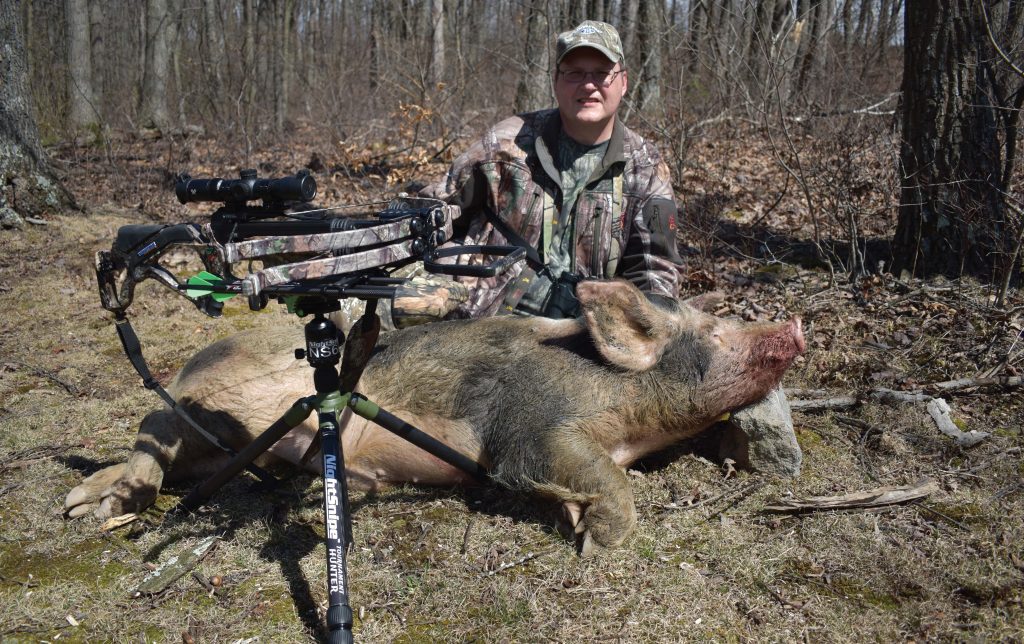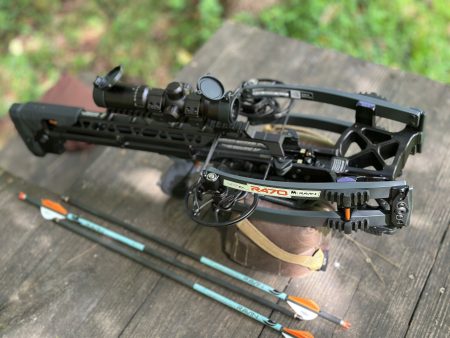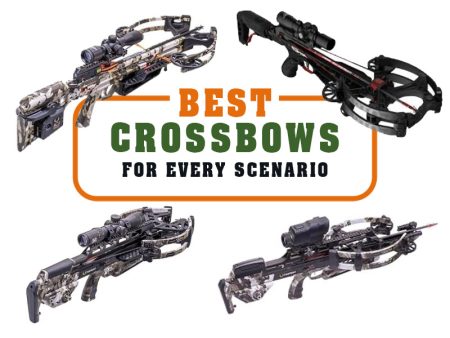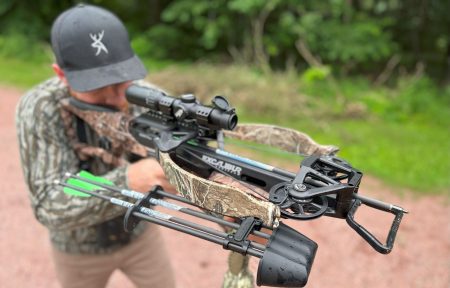After a very tiring and fruitless morning chasing feral pigs through the hills and hollows of Appalachia this past spring, I regrouped and developed a plan for the afternoon with my guide over lunch. During his morning rounds, he found a lone boar that liked to call the far corner of the property home. It was decided that I would try to make a play for that hog in the afternoon. Since I had a decent-sized walk ahead of me, I broke down the new tripod I was testing into its monopod configuration to lighten my load. With its carbon-fiber collapsible legs, it easily fit into my backpack for the initial hike.
Once I neared the back of the property, I pulled the monopod out of my pack and extended its legs to use it as a hiking stick when it came time to descend the rocky hill towards where the guide had last seen the resting boar. About halfway down, I noticed a patch of white against the drab brown of the dead forest floor. Through the binoculars, I made out two pigs lying against a fallen log, soaking up some early April sunshine. Swinging to their downwind side, I locked the Twinstrike into the NightSnipe Saddle and crept closer. At twenty yards I was busted. The two boars stood up and slowly began to walk away. The fluid motion of the NightSnipe ball head made tracking them while maintaining a solid sight picture a breeze. When they turned to check their back trail, the arrow was on its way and found its mark to end my yearly pursuit of a good-eating-sized pig for the freezer.
Crossbows have the inherent advantage of being able to be shot from some sort of rest. While your shooting proficiency without a rest can be improved with practice: if a rest can be utilized, it will certainly increase your odds of placing that arrow where you want it. The downside to utilizing a mechanical rest of some sort is it adds bulk to your gear list and can hinder you if the target changes positions rapidly. For field use, the tripod, bipod, and monopod configurations are the most popular. When I hunt from a blind or fixed position, I prefer the rock-solid tripod platform. For mobile hunting, a bipod or monopod will usually be in one hand. If I am spending time perched in a treestand, a monopod is my choice for its maneuverability.
Crossbow Magazine is no stranger to the fine hunting products being produced by Predator Hunter Outdoors from the great hunter-friendly state of Michigan. We put their NightSnipe hunting lights through their paces a few years ago and still utilize them today. When they contacted me this past winter to let me know about their new product line of tripods and accessories, I was immediately interested to see what they had developed. The two downsides to mechanical rests I mentioned earlier received a lot of attention during the design process. As a result of that, the weight was reduced by utilizing carbon fiber; likewise, the fluidity of movement of the weapon on the rest is endless through the use of a ball head pan and tilt mount. What truly sets the new NightSnipe Tournament Hunter tripod apart from the competition is the ability of the user to break the unit down into a monopod configuration. Essentially, we now have a one size fits all rest for every hunting application.

After discussing my hunting style with NightSnipe, I ordered the Tournament Hunter tripod with their NightSnipe NS67 ball head and NightSnipe Shooting Saddle. The Tournament Hunter tripod comes fully assembled and includes a soft-sided carrying case, rubber feet, and steel spiked feet for ice or other slippery surfaces. A quick twist locking ring is utilized to extend or retract the 29mm carbon fiber legs and center neck. Each leg of the Tournament Hunter tripod has three locking angle adjustments to accommodate any terrain variances or stability preferences on the shooter’s part. When folded up for storage, the tripod is only 18 inches in length. Once the legs and center neck are fully extended, the tripod extends up to 68 inches. At its lowest setting with the legs fully collapsed, angled outward and the center neck removed, this tripod is only 8 inches high which opens up the possibility of shooting from the prone position. What sets this tripod apart from the competition is the ability to unscrew one of the legs from the tripod to quickly convert it into a monopod configuration. I much prefer a monopod for stand hunting and in this configuration, it doubles as a trekking pole, which my aging body often finds useful. The total weight of the tripod is only three pounds, and it is rated at thirty-three pounds. The NightSnipe NS67 aluminum alloy 44mm ball head is rated to 45lbs and adds 4 inches to the tripod height. A quality ball head is where the magic happens with a high-quality field rest. Due to its design, a ball head allows for very fluid motion in any plane of movement, but in a controlled way. A tension control knob allows the user to customize the tension required to move the weapon. If this is adjusted correctly, the weapon will not move if the shooter removes his hands from it, but the slightest pressure imparted to it results in fluid motion in any plane. If zero movement is wanted, the NS67 can be also fully locked. For those of us shooting crossbows, canting of the weapon can be an accuracy killer at extended distances. Three bubble levels are built into the NS67 to ensure that the shooter can acquire a perfectly level shooting platform in any situation. If you are using the monopod, the NS67 easily unscrews from the tripod and attaches to the monopod leg. For flexibility, the NS67 is also compatible with Picatinny, M-LOK, and KeyMOD mounts. The connection between the ball head and the crossbow has to be rock solid, and the NightSnipe Shooting Saddle does not disappoint. Even though the ball head and saddle mount areconnected with a quick disconnect mount, once it is locked in, the union is robust. Constructed of machined anodized aircraft-grade aluminum and ultraviolet resistant padding, the saddle mount can accommodate rifles, shotguns, and the thickest crossbow forends that are out there. Once you secure the crossbow into the mount with the locking knob, there is absolutely no movement at all. The saddle mount will add another 3 inches to the total height and weighs in at just over a pound.
Performance in the field and at the range has been without issues. The NightSnipe Tournament Hunter tripod has become my go-to field and range rest. One of my hunting buddies was so impressed with it, he asked to borrow it for a western elk hunt this coming fall. Its lightweight, solid construction, adjustability, quality components, and the ability to transform from a tripod to monopod in minutes are not unexpected from Predator Hunter Outdoors. Based on my experience with their products, I had high hopes for this new rest, and they did not disappoint. From a crossbow hunter’s perspective, this rest has all of my bases covered and I am confident it will cover all of yours.
Please visit www.predatorhunteroutdoors.com to see their comprehensive product lines that will have you covered at the range and in the field.
Per our affiliate disclosure, we may earn revenue from the products available on this page. To learn more about how we test gear, click here.






